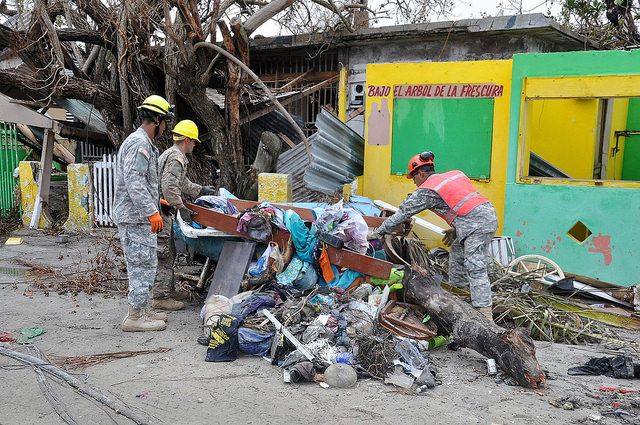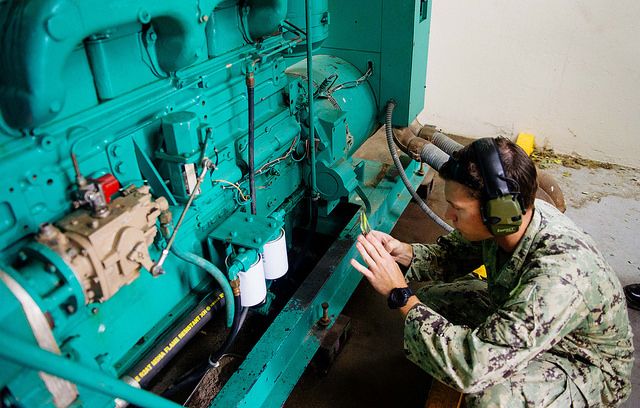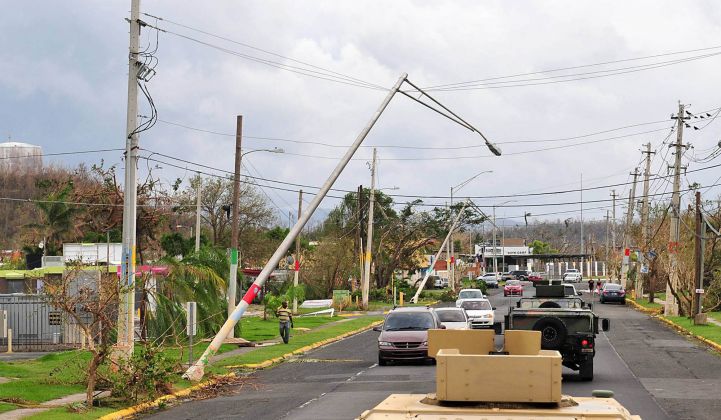After Hurricane Maria hit Puerto Rico, taking down all electricity and most communications with it, Cecilio Aponte was able to get in contact with his family there relatively quickly. Through a brief phone call and a few texts, his mom nailed down uncles, aunts and cousins in Aguadilla and Moca on the western edge of the island.
But two weeks after the eye of the storm bore down on Puerto Rico, though Aponte’s family was able to communicate their safety and one aunt can get cell service if she stands on her still-intact roof, none had grid power. They were relying on diesel generators and rapidly dwindling supplies of fuel.
Now, three weeks since the storm, only about 17 percent of Puerto Rico has electricity. The lack of power has severely exacerbated the growing humanitarian crisis. Food sits rotting on shelves, the majority of hospitals are relying on generators, and with 40 percent of the island still without running water, the likelihood for disease has increased.
The lack of power disproportionately threatens the most vulnerable -- such as those who rely on dialysis, those without the means to buy generators, and those who live in remote areas -- but as the weeks stretch into months without electricity, the impacts on all Puerto Ricans on the island will be wide-ranging.
While the U.S. president has literally thrown paper towel rolls at the problem, private citizens and industries have stepped in to coordinate efforts. The renewable energy industry, for one, has seen aiding in the crisis as both a moral imperative and an opportunity to demonstrate the effectiveness of its technology. Though some in the renewables industry have cautioned against putting the cart before the horse when so many lives are still in peril, many have also raised questions about the future.
Several companies and experts have seized on the power outages as a segue to discuss long-term resilience and the potential for distributed energy to protect island grids. Aponte, a current fellow at the Clean Energy Leadership Institute, said the destruction has compelled him to consider a future rebuilding Puerto Rico’s grid.
“What got me into energy in the first place was energy access and global equity. I realized that part of the U.S. -- and the place my family’s from -- has those issues,” said Aponte. “Resiliency is great, yes. But besides people just talking about it, how is it going to happen on the island in a way that’s going to keep happening and not just be a fad after a hurricane?”
Destruction
When I catch up with Alejandro Uriarte, president of San Juan-based solar company New Energy, he’s just returned from a meeting with cell phone providers about how renewables might power cell towers now running solely on diesel. When Uriarte describes the status of electrical distribution on the island, he speaks of complete devastation. “Everything is gone,” he said.
Renewables installations, though, fared a bit better. Uriarte said all of his solar installations sustained some damages, affecting maybe 10 to 15 percent of the panels. That’s a much better percentage than the estimated 80 percent of transmission lines that were taken down. But Uriarte notes that because nearly all existing renewables systems were connected to the island’s now-destroyed grid, most are still unable to produce energy.
“Our work has certainly changed from selling grid-interconnected solar equipment to selling storage for those systems that were already installed, or selling solar-plus-storage to be off-grid until the grid comes back,” said Uriarte. “Then we can talk about interconnecting them.”

The Puerto Rico National Guard helps to control the damage after Hurricane Maria slammed into the island.
Most renewable companies with a presence on the island are in immediate repair mode. Although Puerto Rico, like all Caribbean islands, relies heavily on fossil fuels for power, the island did have 215 megawatts of solar before the storm. Companies such as Sunnova, Tesla (New Energy is a certified Tesla installer), and Sonnen have residential and small-scale projects. Sonnen said all its systems fell offline after the hurricanes. It’s working on stabilizing its existing fleet, and has started working with solar installer Pura Energía to provide new microgrid systems for sale and some for free. Sunnova was also working to repair parts of its 10,000 installed systems.
Many other companies and clean energy trade associations have also pledged to divert supply to help in the short term. After a call for coordinated efforts, the Solar Energy Industries Association received 160 responses with offers for help. The Distributed Wind Energy Association (DWEA) is coordinating microgrid deliveries from three manufacturers with funding from United Wind. And on Friday, Tesla CEO Elon Musk spoke on the phone with Puerto Rico’s governor, Ricardo Rosselló, about how the company’s solar and battery technologies can contribute to immediate relief efforts, and possibly remake the grid entirely.
"Emergency mode" and beyond
Clean energy manufacturers and resilience experts are asking what can be done to harden the island’s grid even in the initial stages of Puerto Rico's recovery.
“Typically, investments that are made right after a storm, almost in emergency mode, you can see 10 years later those investments have remained,” said Roy Torbert, principal at the Rocky Mountain Institute’s Islands Energy program. “Ask these questions now, so the investments you make for the long term are the right way to go.”
But what works in such extreme weather is not a given. The strength of Maria was nearly unfathomable. It hit Puerto Rico as a category 4 storm with 155-mile-per-hour winds that reached 60 miles from its core and tossed roofs, snapped pine power poles, and tangled the island’s aboveground transmission wires. Gusts on the island reached 195 miles per hour.
With such strong storms, it’s not guaranteed that distributed renewable energy infrastructure would hold up much better than traditional electricity. According to Torbert, solar panels are generally designed to stand up to a category 4 storm and their ability to withstand strong storms depends on the quality of their foundation. In Puerto Rico, Uriarte said, panels are required to withstand 145-mile-per-hour winds. Maria was stronger than that when it made landfall on the island, and much stronger when it blew through islands like Dominica with 175-mile-per-hour winds. Just before Maria arrived, Hurricane Irma brought winds of 185 miles per hour to some Caribbean islands.
Though renewable installations on islands like Puerto Rico did sustain damage, renewable companies and advocates say distributed sources that could function apart from the grid would be easier to repair and get back on-line than centralized power and distribution. To brace for a storm, Torbert said nacelles on wind turbines can be tilted down and the blades turned away from the wind so they don’t over-spin.
Adding storage systems to solar and wind installations would allow resources to start providing power even if distribution and transmission remained down. Jennifer Jenkins, executive director at DWEA, explained that manufacturers in the distributed wind space originally worked on off-grid installations in remote areas. She said distributed wind systems make sense on islands and, when combined with storage, could keep electricity available in the absence of grid power.
Other, more basic infrastructural changes -- such as replacing wood poles with concrete and installing transmission lines underground -- could also prevent such widespread outages.
"An increasingly brittle transmission system"
Even before the storm, Puerto Rico’s electric grid was a delicate system. Its utility and sole electricity provider, the Puerto Rico Electric Power Authority (PREPA), has become notorious for its $9 billion bankruptcy and poor management. The Puerto Rico Energy Commission (PREC) enshrined its issues in a 2016 report, writing, “the severe outages, deferred maintenance, and a lack of experienced staff have resulted in an increasingly brittle transmission system.”
According to Torbert, the aftermath of the hurricane “requires an immediate reckoning” with PREPA’s difficulties. Almost everyone interviewed for this story expressed concerns with the functioning of the island’s utility.
“The entire organization, PREPA, stem to stern, top to bottom, is incapable of carrying out its mission,” said Tom Sanzillo, director of the Institute for Energy Economics and Financial Analysis. “It’s largely a function of upper management and the toxic effect it has on the morale and competency of the workers.”
Uriarte, too, expressed frustrations, specifically about the lack of commitment he sees from PREPA on transitioning to clean energy. “They have never come out against renewables,” he said. “They always say they’re friendly to renewables. But in practice, they are not.” To get approval for interconnections to the grid and commercial renewable projects, Uriarte said, the permitting process is maddeningly slow.
But placing the blame squarely on PREPA ignores Puerto Rican and U.S. history. Buried lines, which are also more vulnerable to flooding, can cost anywhere from four to 14 times more than those above ground. Renewables prices have become increasingly cost-competitive with traditional fuels, but distributed renewable energy still requires significant investment.

U.S. Navy sailor inspects a diesel generator at a hospital in Puerto Rico.
Puerto Rico doesn’t have an excess of cash. Over a century of the United States holding Puerto Rico at arm's length has left Puerto Rico with debt in the billions of dollars. As debt piled up, Puerto Rico and PREPA continued to be second priorities for the mainland.
Over the years, PREPA has also had to cope with a shrinking workforce as 30 percent of its workers retired or left for the mainland. The 2016 report from PREC notes much of PREPA’s work had become “triaging” in the place of preventative maintenance. In 2016, President Obama signed the Puerto Rico Oversight, Management, and Economic Stability Act. That act created a board that this summer rejected a restructuring deal for PREPA's debt.
"That decision was encouraging in that it suggested support in Washington for an actual path to recovery for the power authority," Sanzillo wrote in an opinion for The Hill. Recently, the utility has floated privatization to deal with its economic shortfall.
“We have the technology,” said Aponte. “But if we can’t fix the money piece, then the technology means nothing. That’s scary.”
In the absence of strong management from PREPA, Uriarte said the conversations about a modernized grid bubbling up among renewables advocates are necessary. “Just imagine if there was an honest conversation about this. The utility says, 'For us to take power to this community in the middle of the mountain on the west side is going to take a year,'” he said. “The solar could industry could say, 'Hey, we could put a microgrid there in four months' and resolve the issue faster.”
For now, Gov. Rosselló has said modernizing the grid would happen in tandem with repairing what’s left. But because of the dire situation on the ground, designing and fashioning that new grid may fall to entrepreneurs, like Musk, and companies with the means. José E. Sánchez, head of the Army Corps of Engineers task force to restore power, told the New York Times that the Federal Emergency Management Agency is working on repairing and replacing, but not improving.
“This is a devastating situation,” said Jenkins of the DWEA. “But it really does give us this very unique opportunity to rebuild a grid and to do that with clean technology. We really need to do it right.”




